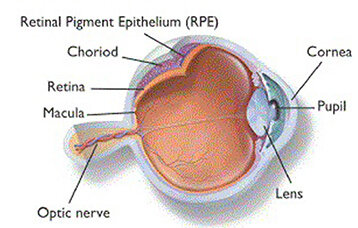What is Stargardt disease?
While Macular Degeneration is normally associated with ageing eyes, an inherited form known as Stargardt's disease can affect children and young adults. Stargardt disease is a bilateral inherited retinal dystrophy usually affecting the central retina, the macula, resulting in a deterioration of the central vision.
Most cases are due to mutations in the ABCA4 gene. Although classical Stargardt disease is more limited to the macula, the range of presentations associated with mutations in the ABCA4 gene may also affect the peripheral retina, or even cause a more generalised retinitis pigmentosa. This presentation may vary among family members carrying the same two mutations. Fundus flavimaculatus is the name given to a variant of this disorder characterised by flecks in the peripheral retina.
Who does it affect?
There is no predilection for any race or gender. Males and females are affected equally, and the disease is common throughout many countries and ethnicities. Like most autosomal recessive diseases, Stargardt disease associated with the ABCA4 gene is more common in consanguineous relationships. Stargardt disease is the most common inherited disorder affecting central vision and the visual loss can have serious implications on quality of life across social, psychological and health domains.
What are the symptoms?
Symptoms typically begin in early adolescence with reduced vision that may progress to severe central vision loss. However there is wide variability in age of onset and rate of progression.
Blurring of the central vision is usually the presenting symptom, and occasionally this may be associated with altered vision in the dark.
Is it inherited?
Stargardt disease is an autosomal recessive disorder. As we carry two copies of every gene, in a recessive disorder this means both copies that are inherited contain mistakes (or typos) and therefore neither function properly. An individual who carries only one copy of the ABCA4 gene with a mistake, and the other copy normal, are usually not affected at all. The siblings of an individual with Stargardt disease have a 25% chance of being affected, although the offspring of an affected individual usually do not inherit the disease.
Autosomal recessive Stargardt disease is most commonly caused by mutations in the ABCA4 gene. The ABCA4 gene codes for a transporter protein, which pumps waste products out of the photoreceptor cells at the back of the eye, called the retina. If the pump is not working properly, or as well as it should, then these wastes accumulate, eventually damaging and killing the cells, no more of these cells can be made once they have died.
Some Stargardt disease is due to a single mutation in the ELOVL4 gene, is inherited in an autosomal dominant manner, meaning any offspring of an affected individual has a 50% chance of being affected.
How is it diagnosed?
Stargardt disease is diagnosed on the basis of history, examination, imaging of the retina with fundus autofluoresence and electrophysiological testing. Genetic testing can confirm the diagnosis. A variety of clinical presentations are presented in the accompanying images.
Figure 1. Right and left retinal images from an individual affected with Stargardt Diseae due to homozygous mutations in the ABCA4 gene. The central pale area involving the macula is atrophic, or scarred, with some pigment clumping in the right eye.
Figure 2. Widefield retinal photos of individual with the fundus Flavimaculatus variant demonstrating white flecks in the mid retinal periphery, along with a maculopathy. This individual has 2 different ABCA4 mutations.
Figure 3. The images to the right show the fundus autofluoresence obtained from the same individual, centered on the macula. The dark areas are where retinal tissue is poorly functioning, and the bright white areas correspond to the flecks in the retina, and are likely to represent areas of the retina under stress.
Are there any treatments?
Two clinical trials are currently underway. One includes gene replacement therapy of the altered ABCA4 gene, injected into the eye. This trial is called StarGen, and is currently in the safety and toxicity phase of research.
The other trial involves stem cell injections in to the eye, but is still in the early phases of research.
A multicentre project is currently underway to establish the natural history and progression of Stargardt disease, so that any intervention can be appropriately monitored and assessed.
What are future treatments?
Further treatments include an oral medication designed to stop the waste products accumulating in the presence of ABCA4 mutations. Other oral medications and gene related therapies are under development
Living with Stargardt Disease/support
The advice given for MD applies to Stargardt disease. A healthy lifestyle, good nutrition and protection form ultraviolet sunlight is the most useful advice at this time.
You will find further information about other low vision services that provide guidance and support here




